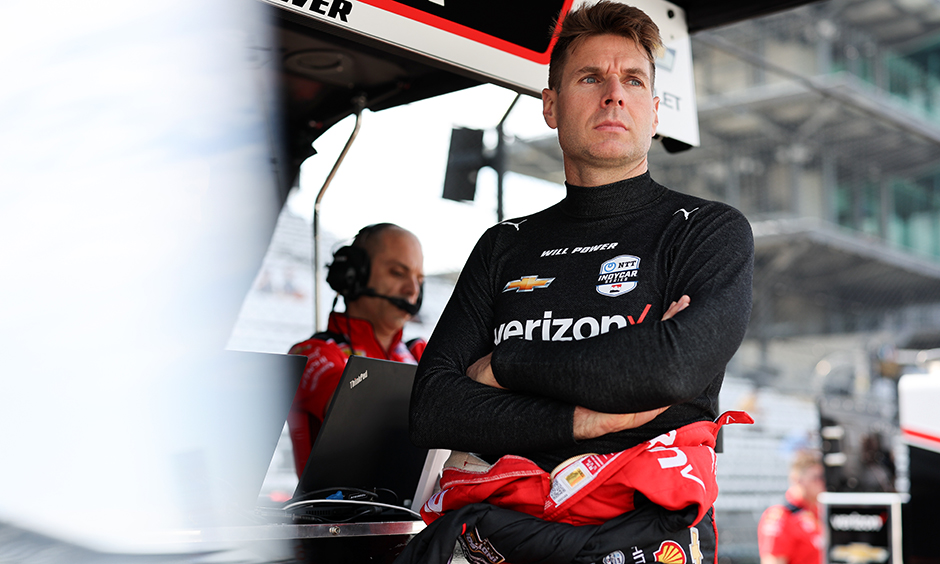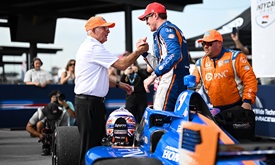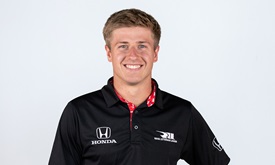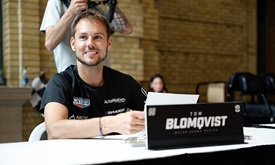The Setup: Portland with Dave Faustino
AUG 29, 2023
Note: This is a continuing series for INDYCAR.com with different guests leading into each race weekend for the NTT INDYCAR SERIES, focusing on various technical challenges of each respective circuit.
The 16th and penultimate round of the 2023 season for the NTT INDYCAR SERIES heads to Portland International Raceway, this weekend’s BITNILE.COM Grand Prix of Portland.
The 12-turn, 1.964-mile permanent road course first hosted an INDYCAR SERIES race in 1984, and the current iteration of the event began in 2018. The front straightaway is 2,450 feet while the back straightaway is 2,180 feet. There are three left turns and nine right turns. Track width varies from 30 feet to 78 feet.
The three-day event features two practice sessions and an NTT P1 Award qualifying bout ahead of Sunday’s 110-lap (216.04 miles) race at 3 p.m. ET (NBC, Peacock, INDYCAR Radio Network).
The single-lap qualifying record is held by Team Penske driver Will Power, who posted a time of 57.2143 seconds in 2018. This week’s featured guest is Dave Faustino, race engineer for Power’s No. 12 Verizon Team Penske Chevrolet.
Q: What is it like preparing for Portland International Raceway?
Faustino: It’s a flat track, and there aren't, from a road course standpoint or pretty much any road course, with this sort of profile. Portland has a lot of very long-duration corners, and it's a very fast lap. In general, it’s a sub-60-second lap for 2 miles, and the challenge is trying to get a car that can roll (high) corner speed through those long-duration corners. Then you’ve got Turn 4, which links directly into Turn 5, which links directly into Turn 6, and then that links directly into Turn 7, so for a good percentage of the entire lap time you're cornering.
Also, these are flowy corners without a lot of braking, so all you can do really is roll speed and have reasonable exits. On the flip side, you're trying to balance that with the other side of the track, which is (Turns 1 and 2), which is braking with low-speed traction, a little more street course-esque, if you will. So, there’s a compromise to be struck because a setup that turns really well doesn't typically have great traction and sometimes braking capability is compromised. On top of that, you throw in Turns 10 and 11, a section which is almost flat out, super-high speed, super-high commitment. That tends to destabilize the car, as well. It’s difficult to link all that together because we don't have any other track that is that flat and has that kind of corner speed and corner duration. So, I'd say it's a lot about striking a compromise there to achieve a good overall lap time.
Q: I know we're not going to talk trade secrets because that's not the objective here, but when you’re looking at Portland from an engineering point of view, what are you working with given you have to compromise so much?
Faustino: Yeah, well I think you have to look at where you spend a lot of your time, and so from a qualifying perspective, you might have a corner like say (Turns) 10-11 – it's really fast at the end of the back straight, but how much time are you really spending there relative to linking (Turns) 4-5-6-7, which like I said is a huge percentage of the total lap time. When you're looking for lap time, and it's not really a trade secret, you have to focus on where the sensitivities are for overall lap time, especially when it comes to qualifying. So, you're just looking at that. You're looking at, ‘OK, I think that because of where we're spending this time from a percentage standpoint, these are the corners that are going to net the most benefit, so let’s focus on those and do the best we can in other places.’ Now, when it comes to racing, that can flip a little bit at Portland because the one straightaway that has passing opportunities, you lead onto that by getting through 10, 11, and 12 fast. So, you might target catering to that sector a little bit more, I should say, than what you're doing for qualifying. I think that's the general approach you would take.
Q: What about the ride heights?
Faustino: As far as the bumpiness, (Turns 1 and 2) have concrete. That’s the bumpy area of the track, and you have a bit of a roller coaster ride there. If you look at what the drivers do when they ride the curb through Turns 10-11 and into 12, there's some heave there coming on and off the curbing. But generally speaking, the bumpy stuff is (Turns) 1 and 2, and the rest of the track is smooth. So, you don't really have to tailor your ride heights for the bumps there because the bumps are in the slower corners, so you're not bottoming out due to the bumps. You do have to watch your ride height in qualifying when they send it into (Turn) 10 and 11 because you're at the end of the straight, and the car's pretty much on the ground there.
And then they almost turn into that corner flat and use a little bit of the curb on the left side going into 10, and it can kind of roll over and bottom out a little there. That’s really all you have to watch out for – the rest is a bit of a compromise. If you run your car stiffer and lower, you're going to pick up time in 4, 5, 6, 7, but you are probably going to lose a little bit of time in Turns 1-2. So, that goes back to my balance of where you think a lot of time is because 1-2 is a little more street-coursey, a little more bumpy. I think ideally you would run the car softer at 1-2 if you could and then run it stiffer in 4-5-6-7 if you could. That just comes down to whatever compromise you feel is best for your driver and an overall lap time.
Q: You're making Portland sound so simple, man.
Faustino: It’s not, and we generally find ourselves really boxed in there, and then it's hard to find that balance because of the reasons I mentioned. You want to try to make the car turn, and that’s going to destabilize it in other areas, and it is going to start to affect the traction. And at some point it comes down to the driver trying to give you the information when you're at that point. I think we probably went a little too far last year. Our teammate (Scott McLaughlin) got the pole there, but it really does come down to that. It is completely a compromise situation.
Q: When you have a track layout like this one, how tricky does that make trying to find the right gear setup? Because, like you said, you've got the straight, which is a great passing opportunity therefore requiring one type of gearing, but at the same time you don’t want to suffer being able to get out of the corner, as well. What’s the challenge of a compromise?
Faustino: Portland is not that bad when it comes to that, to be honest with you, because there are long-duration corners where you can't be shifting there. And the corner speeds there have enough variance, meaning you have some low speed, some medium speed, some high speed to where the drivers can typically find a gear, you know, one of the six that'll work for each corner. I'd say it's actually less challenging from a gearing standpoint then someplace like …
Q: Road America comes to mind instantly.
Faustino: It's actually the tracks that have a lot of corners at somewhat similar speeds because you then put yourself between gears where this corner is only 7 mph faster than another corner. We see that a lot at like at St. Petersburg, the old Detroit track at Belle Isle. You have a lot of corners that are right in between – say first and second gear – and drivers always feel awkward at the natural road courses where you have like more speed separation. It becomes a little easier to deal with when you’re flowing a little more so you're not as dependent on acceleration. So, it’s not as big of a challenge at Portland as it can be at some street courses.
Q: What is the one section of this track or that one corner that might be the trickiest of all?
Faustino: The answer from the engineering perspective is probably different than the driving perspective. From our side, the hardest to get right is Turns 10-11 and the entry to 12. It’s the compromise with the rest of the track because you are trying to put the car in a situation where you're running the car as low as possible, but you don't want to disturb it through the high speed if you can. So, you have to keep your eyes on that, and you have to understand how much faster you might go because if the car gets upset because it’s too soft and it rolls or bottoms or whatever, and you weren’t prepared for it. If that happens in 11, it messes up 12. From a driving standpoint, you’re trying to get your driver to have a commitment in that super high-speed section of 10 and 11 before they set up for 12. So, there’s a little bit of a fine line from an engineering standpoint to anticipate what might happen, where the other corners are a little more straightforward, so you’re shooting for good rolling speed and trying to have a good balance.
Q: What’s the trick to finding a balance that works for qualifying versus trying to make sure you find a balance that’s going to work in the race over an entire stint?
Faustino: There's really no trick to it other than just trying to get a really good long run after qualifying. Then in the warmup session, if you can, if your car is reasonable enough to where the driver will be tolerant enough to do a long run without worrying about putting up a big lap time, you just focus on the reality of a heavy car and run as long as you can to see which way it goes. Then you adjust from there for the conditions, the weather, the tires you’ve used and hope you are close enough to where you’re getting a good read on things.
Q: You are the first person in our series this season to not question the value of the warmup session.
Faustino: Oh, wow.
Q: It’s cool to hear it adds value. Of course, you assume it does.
Faustino: Honestly, it's one of the more important sessions because no one is practicing long runs leading up to qualifying. You don't have enough tires to do it, either. So, the warmup session is the only session you have to put in a long run, and it is really only opportunity to see what's going to happen in the race. And these days, we typically have a little more tire degradation than there’s ever been in INDYCAR, so it’s really important.
Q: This is the final question: You’ve obviously got a great driver in Will Power, a really special talent behind the wheel. The two of you are previous winners at Portland. How does he seem to be so good at Portland?
Faustino: Well, I think Will, in general, is one of those drivers that likes to make lap time by carrying speed in and into the middle of the corner. And he's usually reasonable at hanging onto a car that's approaching that edge – that’s knife’s edge of balance – to where you can do that. I think that’s what gives him an edge there. If anything, we might have to reel him back a little to make sure we haven’t gone over the top. That’s what we’ll be focusing on.



















